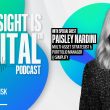There’s an old saying in investing: past performance is no guarantee of future results. It’s a phrase so often repeated that its meaning has been diluted into the noise of compliance boilerplate. But ignore it at your own peril—because if today’s markets have taught us anything, it’s that what worked yesterday won’t necessarily work tomorrow.
Paisley Nardini, Portfolio Manager and Multi-Asset strategist at Simplify Asset Management, has been watching this evolution unfold in real-time. And if her insights during The Insight is Capital Podcast are any indication,1 the financial world is standing at a precipice. Advisors who don’t adapt may soon find themselves irrelevant.
“The group that is not interested in diversification is the group that's looking in the rearview mirror.”
In other words: if you’re still clinging to the old 60/40 portfolio as if it’s a life raft, you’re already drowning.
The Parting of the Red Sea: Two Tribes of Investors
A decade of artificially suppressed volatility, near-zero interest rates, and central bank largesse lulled investors into complacency. But the past two years have shattered those illusions. Market uncertainty, rising geopolitical tensions, and the blunt force trauma of interest rate volatility have triggered a great divide among investors.
On one side are those who already won—the investors who rode the 2010-2021 bull run to the moon and are now in capital-preservation mode. They want to lock in their gains, de-risk, and make sure they don’t give back what the markets have gifted them.
On the other side are the latecomers. These investors missed out on the historic run-up, and they’re hell-bent on making up for lost time. FOMO is their guiding principle, and their strategy consists of triple-leveraged ETFs, speculative moonshots, and chasing the market’s high-flyers like a gambler doubling down on a losing hand.
As Nardini puts it:
“We've had some outsized years for asset class returns. Most of your clients are likely sitting on meaningful gains… The big topic for the last two years is there’s been no tax loss harvesting at the end of the year because everything’s up.”
For one group, the play is now defense. For the other, it’s all-in.
Diversification Isn’t Dead—It’s Evolving
If there was one fatal flaw in traditional diversification strategies, it was this: diversification within correlated assets isn’t diversification at all.
This, Nardini argues, is the single biggest misunderstanding among advisors and investors alike.
“You’ll think about diversifying broadly across all these different equity segments, factors, geographical exposures… but that’s not giving any breadth to the portfolio—it’s just giving it depth.”
The reality is that many so-called diversified portfolios are merely elaborate bets on a single factor: economic growth. Whether it’s U.S. large caps, small caps, international stocks, or credit markets, they are all fundamentally tied to the same macroeconomic cycles.
True diversification requires stepping beyond the comfort zone of traditional equity and fixed-income allocations. It means embracing structural return premia—investment strategies that aren’t just uncorrelated in theory, but in practice.
And that’s where things get uncomfortable.
Derivatives: The Institutional Play That Advisors Must Learn
Once the exclusive domain of hedge funds and institutional investors, the post-2020 era has seen a dramatic shift in accessibility. Rule changes, product innovation, and a new wave of actively managed ETFs have given advisors the ability to tap into sophisticated strategies without the operational nightmares of separately managed accounts.
Nardini is clear on the opportunity:
“A big part of what we do at Simplify through the use of derivatives is what made PIMCO famous… It’s what we call structural alpha.”
What does that mean in practice? It means utilizing capital-efficient strategies that free up liquidity while simultaneously mitigating risk. It means taking advantage of convexity, flow-driven investing, and tail-risk hedging—without tying up capital in inefficient hedges like long-duration Treasuries.
“I hate to use the word leverage because that always has this negative connotation. But leverage is actually a beneficial thing when it comes to thinking about building a balanced portfolio and being capital efficient… freeing up your clients' capital to put towards return drivers.”
In other words: institutional-grade portfolio construction is no longer optional for advisors. It’s the only way to compete.
Edge of Chaos: The Market’s New Normal
The backdrop for all of this is an increasingly volatile world. Markets are no longer reacting to simple macroeconomic indicators—they are thrashing between extremes, driven by a combination of geopolitical uncertainty, inflationary pressures, and unpredictable monetary policy.
Nardini calls this the edge of chaos, a concept borrowed from complexity theory that describes the delicate balance between order and disorder.
“We’re skating on thin ice. Every day, we’re getting new information that’s pushing markets higher, pulling markets lower… We have to recognize that we’re in an environment where the ground is constantly shifting beneath us.”
This isn’t a time for high-conviction bets. It’s a time for building portfolios that can absorb shocks, react dynamically, and avoid the pitfalls of binary, all-or-nothing market calls.
So What Should Advisors Do?
The answer is both simple and difficult: adapt or die.
- Break Free From 60/40 Thinking
- Carve out up to 20% of the portfolio for alternatives—and not just for the sake of it. Choose assets and strategies that truly provide non-correlated return streams.
- Embrace Institutional-Grade Portfolio Construction
- Use derivative overlays, options-based strategies, and tail-risk hedges to create structural resilience.
- Be Dynamic, Not Passive
- Active management isn’t just about stock picking anymore. Systematic strategies, trend-following models, and dynamically adjusted exposures are the new frontier.
- Educate Clients to Avoid Behavioral Pitfalls
- Advisors must set expectations. As Nardini warns:
“The biggest challenge isn’t the portfolio—it’s the psychology. Clients will compare their performance to whatever hot stock their neighbor bought last week.”
- Advisors must set expectations. As Nardini warns:
- Utilize Solutions That Make Implementation Seamless
- ETFs with embedded structural alpha, convexity management, and dynamic positioning can help advisors make meaningful shifts without overwhelming their clients.
The Bottom Line
Markets are entering a period of profound transformation, and old playbooks no longer apply. The advisors who cling to outdated paradigms risk becoming obsolete. Those who embrace change—who integrate structural alpha, rethink diversification, and proactively manage risk—will thrive.
Nardini puts it bluntly:
“I truly think that diversification is back. I’m not saying sell all your passive management. I’m not saying get out of equities. But we need to think beyond a stock-bond portfolio.”
This is the new era of investing. If you’re not evolving, you’re already behind.
Source:
1 "Market Outlook—Time for Tail-Risk Protection?" AdvisorAnalyst, 18 Mar. 2025, advisoranalyst.com/2025/03/18/paisley-nardini-outlook-is-it-time-for-tail-risk-protection.html.














